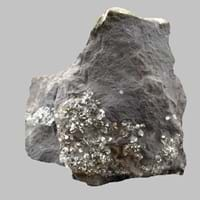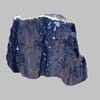Definition
Tuff is a type of rock made of volcanic ash ejected from a vent during a volcanic eruption
Argillites are highly compact sedimentary or slightly metamorphosed rocks that consist largely or wholly of particles of clay or silt but lack the fissility of shale or the cleavage characteristic of slate
Discoverer
Unknown
Unknown
Etymology
From a Latin word tophous then in Italian tufo and finally tuff
From Latin Argilla (clay) and -ite in English which became agrilla+ -ite = Argillite
Class
Igneous Rocks
Sedimentary Rocks
Sub-Class
Durable Rock, Medium Hardness Rock
Durable Rock, Soft Rock
Group
Volcanic
Not Applicable
Other Categories
Fine Grained Rock, Opaque Rock
Fine Grained Rock, Opaque Rock
Texture
Clastic, Pyroclastic
Clastic, Polished
Color
Brown, Grey, Yellow
Dark Grey to Black, Pink, Red, White
Durability
Durable
Durable
Scratch Resistant
Yes
Yes
Appearance
Dull, Vesicular and Foilated
Rough and Dull
Interior Uses
Decorative Aggregates, Entryways, Flooring, Homes, Interior Decoration
Decorative Aggregates, Homes, Interior Decoration
Exterior Uses
As Building Stone, As Facing Stone, Garden Decoration, Office Buildings, Paving Stone
As Building Stone, Garden Decoration, Office Buildings
Other Architectural Uses
Curbing
Curbing, Whetstones
Construction Industry
Building houses or walls, Construction Aggregate
Used for flooring, stair treads, borders and window sills.
Medical Industry
Not Yet Used
Not Yet Used
Antiquity Uses
Artifacts, Monuments, Sculpture, Small Figurines
Artifacts, Monuments, Sculpture
Commercial Uses
Creating Artwork
Fire resistant, Used to manufracture paperweights and bookends
Types
Welded tuff, Rhyolitic tuff, Basaltic tuff, Trachyte tuff, Andesitic tuff and Ignimbrite.
Not Available
Features
Always found as volcanic pipes over deep continental crust
Is one of the oldest rock
Archaeological Significance
Famous Monuments
Easter Island in the Polynesian Triangle, Pacific Ocean
Data Not Available
Famous Sculptures
Data Not Available
Data Not Available
Formation
Tuff is formed when large masses of ash and sand which are mixed with hot gases are ejected by a volcano and avalanche rapidly down its slopes.
An argillite is a fine-grained sedimentary rock mainly composed of clay particles which forms from lithified muds which contain variable amounts of silt-sized particles.
Mineral Content
Calcite, Chlorite
Biotite, Chlorite, Feldspar, Micas, Muscovite or Illite, Plagioclase, Pyrite, Quartz
Compound Content
Hydrogen Sulfide, Sulfur Dioxide
Iron(III) Oxide, Potassium Oxide, MgO, Silicon Dioxide
Types of Metamorphism
Burial Metamorphism, Cataclastic Metamorphism, Contact Metamorphism, Hydrothermal Metamorphism, Impact Metamorphism, Regional Metamorphism
Not Applicable
Types of Weathering
Biological Weathering, Chemical Weathering, Mechanical Weathering
Biological Weathering
Types of Erosion
Chemical Erosion, Coastal Erosion, Glacier Erosion, Sea Erosion, Water Erosion, Wind Erosion
Chemical Erosion
Grain Size
Fine Grained
Fine Grained
Fracture
Uneven
Conchoidal to Uneven
Streak
White
White to Grey
Porosity
Highly Porous
Highly Porous
Luster
Vitreous to Dull
Waxy and Dull
Compressive Strength
Not Available
Cleavage
Not Available
Slaty
Toughness
Not Available
2.6
Specific Gravity
2.73
2.56-2.68
Transparency
Opaque
Opaque
Density
1-1.8 g/cm3
2.54-2.66 g/cm3
Resistance
Heat Resistant, Impact Resistant, Pressure Resistant, Wear Resistant
Heat Resistant, Impact Resistant
Deposits in Eastern Continents
Asia
Afghanistan, Armenia, Azerbaijan, Burma, Cambodia, China, India, Indonesia, Iran, Japan, Malaysia, Mongolia, Nepal, North Korea, Pakistan, Saudi Arabia, Syria, Taiwan, Thailand, Turkey, Vietnam, Yemen
Bangladesh, China, India, Russia
Africa
Cameroon, Cape Verde, Eritrea, Ethiopia, Kenya, Libya, Madagascar, Nigeria, Rwanda, South Africa, Sudan, Uganda
Ethiopia, Kenya, Morocco, South Africa, Tanzania
Europe
France, Georgia, Germany, Greece, Iceland, Italy, Netherlands, Poland, Portugal, Spain, United Kingdom
Austria, France, Germany, Greece, Italy, Romania, Scotland, Spain, Switzerland
Others
Antarctica, Hawaii Islands
Not Yet Found
Deposits in Western Continents
North America
Canada, Costa Rica, Panama, USA
USA
South America
Argentina, Bolivia, Brazil, Chile, Ecuador, Paraguay
Bolivia, Chile, Colombia, Ecuador, Peru, Venezuela
Deposits in Oceania Continent
Australia
Central Australia, Western Australia
New South Wales, New Zealand, Queensland, Victoria, Western Australia
Tuff vs Argillite Characteristics
Though some rocks look identical, they have certain characteristics which distinguish them from others. Characteristics of rocks include texture, appearance, color, fracture, streak, hardness etc. Tuff vs Argillite characteristics assist us to distinguish and recognize rocks. Also you can check about Properties of Tuff and Properties of Argillite. Learn more about Tuff vs Argillite in the next section. The interior uses of Tuff include Decorative aggregates, Entryways, Flooring, Homes and Interior decoration whereas the interior uses of Argillite include Decorative aggregates, Homes and Interior decoration. Due to some exceptional properties of Tuff and Argillite, they have various applications in construction industry. The uses of Tuff in construction industry include Building houses or walls, Construction aggregate and that of Argillite include Used for flooring, stair treads, borders and window sills..
More about Tuff and Argillite
Here you can know more about Tuff and Argillite. The life cycle of a rock consists of formation of rock, composition of rock and transformation of rock. The composition of Tuff and Argillite consists of mineral content and compound content. The mineral content of Tuff includes Calcite, Chlorite and mineral content of Argillite includes Biotite, Chlorite, Feldspar, Micas, Muscovite or Illite, Plagioclase, Pyrite, Quartz. You can also check out the list of all . When we have to compare Tuff vs Argillite, the texture, color and appearance plays an important role in determining the type of rock. Tuff is available in brown, grey, yellow colors whereas, Argillite is available in dark grey to black, pink, red, white colors. Appearance of Tuff is Dull, Vesicular and Foilated and that of Argillite is Rough and Dull. Properties of rock is another aspect for Tuff vs Argillite. The hardness of Tuff is 4-6 and that of Argillite is 2-3. The types of Tuff are Welded tuff, Rhyolitic tuff, Basaltic tuff, Trachyte tuff, Andesitic tuff and Ignimbrite. whereas types of Argillite are Not Available. Streak of rock is the color of powder produced when it is dragged across an unweathered surface. The streak of Tuff is white while that of Argillite is white to grey. The specific heat capacity of Tuff is 0.20 kJ/Kg K and that of Argillite is 0.87 kJ/Kg K. Depending on the properties like hardness, toughness, specific heat capacity, porosity etc., rocks are resistant to heat, wear, impact, etc.Tuff is heat resistant, impact resistant, pressure resistant, wear resistant whereas Argillite is heat resistant, impact resistant.





